Hidden Toilets
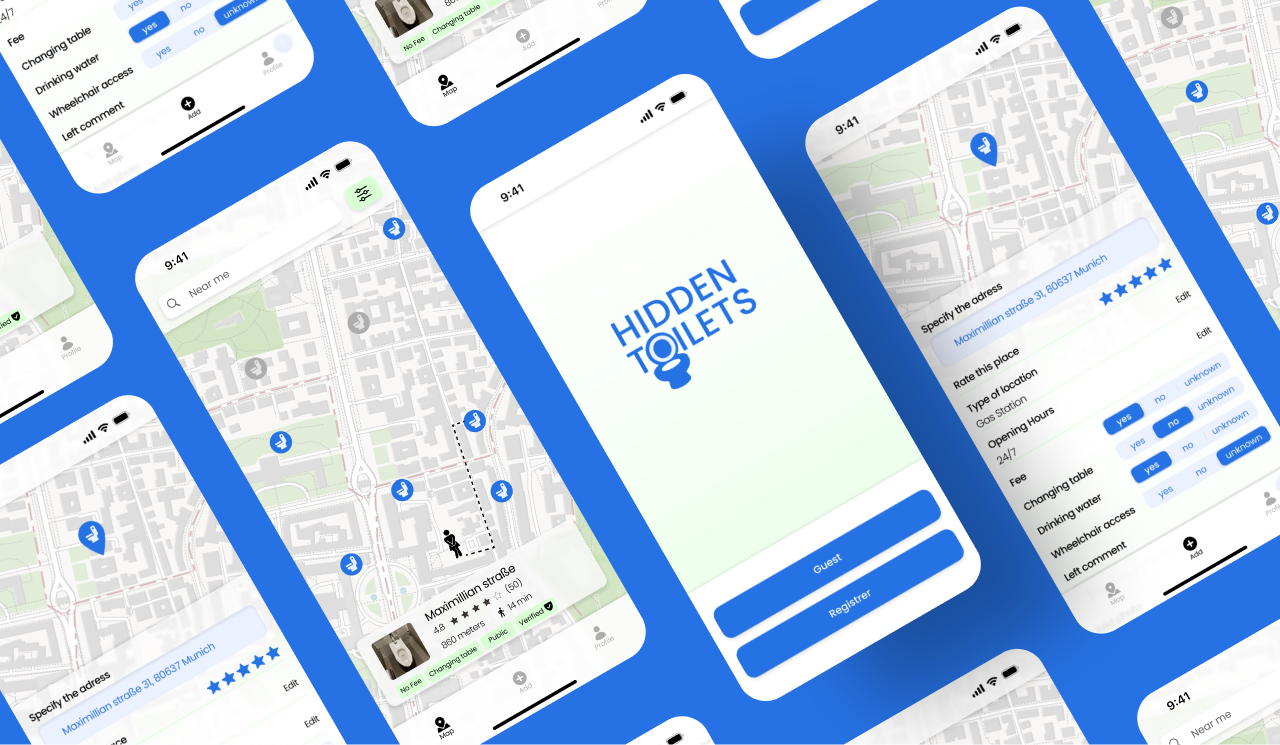
Perhaps each of us has experienced at least once in our lives that we cannot satisfy our basic need to go to the bathroom because it is not available in public places. Sometimes toilets are hard to find, and sometimes they just don't exist. This is especially a problem when you are a tourist visiting a new and unfamiliar place. The inability to satisfy your need causes bad emotions, a negative impression of the city, anger and aggression. Once it happened to me in Paris and I started looking for a toilet on Google Maps and unfortunately the search yielded no results. The information was either outdated or difficult to verify. Interestingly, I later found out that France has a program of automated and self-cleaning toilets. They are being installed in various places, but only local people know about them. Then I thought it would be cool to create an app where you could find toilets, add them, and keep the information up to date. This idea gave birth to the Hidden Toilets app.
Research
To understand the challenges of finding public toilets, I conducted a survey that revealed some surprising insights.- Tourists often feel anxious and stressed when they can't find a restroom in an unfamiliar city
- Hard-to-find clean toilets can lead to using dirty ones or holding it in, harming health.
- City Signs were scarce and unhelpful, sometimes it is a challenge to find them.
- Distance and costs called additional stress.
- Finding a public toilet often requires significant time and effort
- 84% of respondents faced urgent needs with no nearby optionsThis research revealed a pressing need for a dedicated app to find public toilets, especially for younger, tech-savvy travelers. With cleanliness and accessibility at the forefront, this app aims to turn the stressful search for a toilet into a quick and easy task, making life a little more comfortable for everyone on the go.
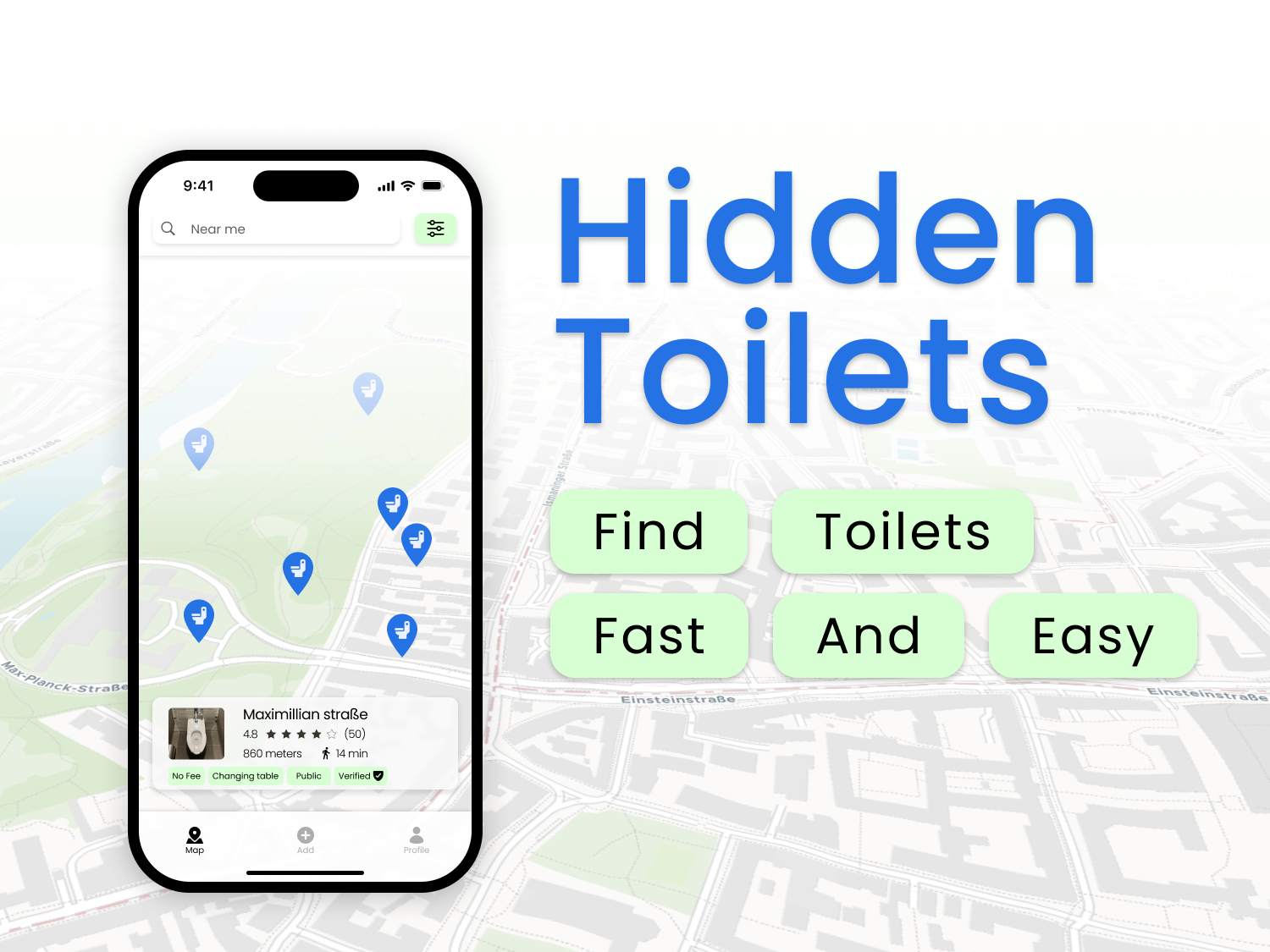
Competitor Analyse
As I delved into the competitive landscape, I uncovered some intriguing insights that bolstered my confidence in the need for Hidden Toilets App. The market, it turns out, is sparsely populated with competitors, each presenting significant gaps and opportunities.Firstly, many existing apps suffer from a lack of up-to-date information. Users are often frustrated by outdated data, leading to unsuccessful searches and heightened stress, exactly the problems I aim to solve. This inconsistency in data management underscored the importance of regular updates and reliable information—key features I plan to prioritize.Secondly, I noticed that several competitors offer only paid versions of their apps. This paywall makes them inaccessible to a broader audience, particularly travelers and casual users who might not want to invest in a subscription for occasional use. The exclusivity of these paid apps leaves a significant portion of potential users unserved, creating a clear opportunity for a free, widely accessible solution.
Through this analysis, it became clear that there is a significant need for a free, reliable, and user-friendly public toilet finder app. The shortcomings of current options highlight the demand and validate the direction. By addressing these gaps, this app can stand out in the market and meet the needs of users seeking clean, accessible, and readily available public restrooms.
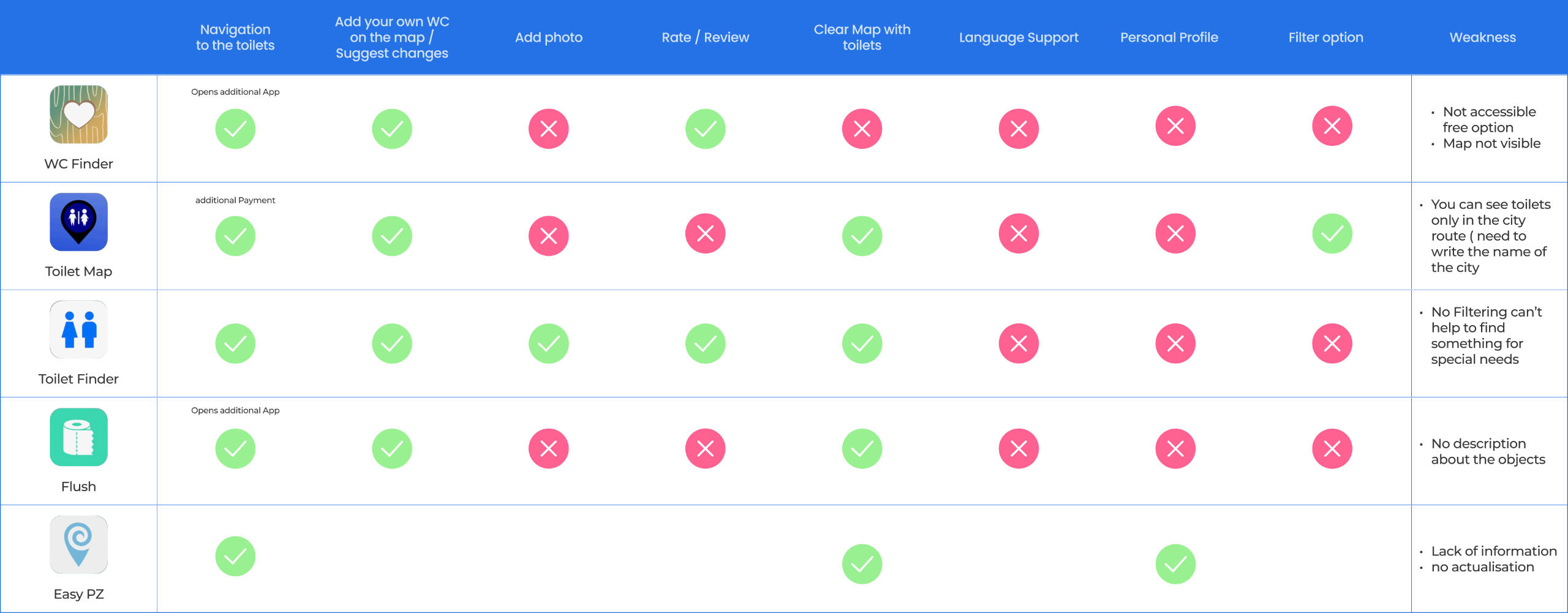
SWOT Analysis
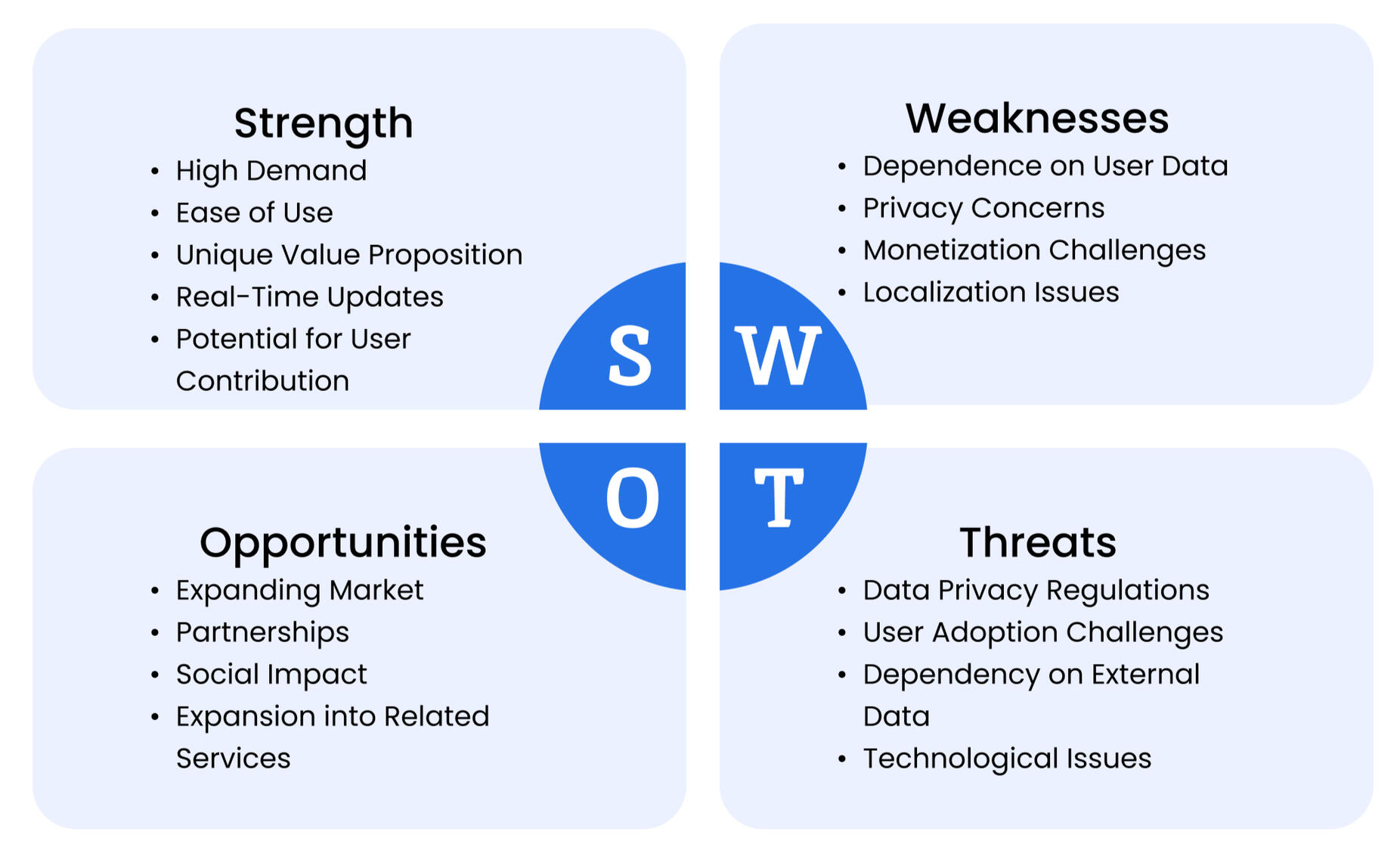
Drawing insights from a detailed analysis of various apps and extensive research, the SWOT analysis of the Hidden Toilets App revealed crucial findings. The analysis highlighted significant strengths, such as the app's ability to meet the high demand for accessible public toilets, particularly among travelers. Its intuitive interface ensures ease of use, allowing anyone to swiftly locate nearby restrooms. A standout feature is real-time updates and user-contributed data, enhancing reliability and community engagement.
However, the analysis also identified weaknesses. The app heavily relies on user data for accuracy, which can vary based on user activity. Privacy concerns surfaced regarding the collection of location data essential for real-time updates. Furthermore, localizing the app across different languages and cultures demands significant resources.
In conclusion, leveraging strengths while mitigating weaknesses is crucial for developing a robust Hidden Toilets App. This SWOT analysis provides a clear roadmap, ensuring the app meets user needs effectively while navigating challenges inherent in its development and deployment.
Features Prioritisation
To ensure Hidden Toilets App meets user needs effectively, I applied the MoSCoW Prioritization Model. This model categorizes features into Must-Have, Should-Have, Could-Have, and Won’t-Have, allowing us to focus on the most crucial functionalities first.
Must-Have features include allowing users to add WC locations, filter WCs based on their needs, check information about cleanliness, and receive real-time updates. These core features ensure that users can quickly find and access suitable public toilets.
Should-Have features encompass the ability to add photos, rate and review toilets, have personal profiles, and integrate navigation with additional maps like Apple Maps. These features enhance user experience and engagement.
Could-Have features might include language support, an emergency button to find the nearest toilet urgently, and different navigation options such as driving or biking. While not essential, these features can significantly improve usability.
Lastly, I decided that a premium paid account feature is a Won’t-Have for the initial iterations of the app. By applying the MoSCoW model, I can prioritize development efforts effectively, ensuring the app addresses critical needs while allowing room for future enhancements. This structured approach aligns with user expectations and market demands, validating the app's potential success.

User Persona
Meet Frank, a 28-year-old freelance graphic designer who embodies the modern-day traveler. With a passion for both work and exploration, Frank finds himself frequently on the move, whether it's for a client meeting in a bustling city or a weekend getaway to unwind. Technology is his ally, and he navigates unfamiliar territories with ease using apps like Google Maps.Despite his tech savvy, Frank faces common challenges that many travelers experience. In his quest for cleanliness and convenience, he often struggles to find hygienic public toilets in new cities. This frustration leads him to rely on cafes or restaurants, but time constraints and availability issues can leave him in uncomfortable situations.

User Journey
User Journey mapping allows me to empathize with Frank’s experience and countless others like him. By tracing his steps and frustrations, I gain invaluable insights into the pain points users encounter. This understanding drives the development of the Hidden Toilets App, ensuring it addresses real-world needs effectively.Through User Journey analysis, I can visualize the entire experience—from initial search to resolution—and identify opportunities to enhance usability, provide accurate information, and ultimately improve user satisfaction. It's a tool that not only informs my design decisions but also validates the necessity and impact of this app in simplifying the lives of travelers like Frank.

Site Map
In crafting the Public Toilet Finder App, I placed a strong emphasis on mapping and user flow to ensure a seamless and intuitive experience for users. These elements are pivotal in guiding users effortlessly through the app, whether they're seeking nearby facilities or contributing new locations.
The Site map and User Flow serve as the backbone of the app's navigation. They provide a clear structure that helps users easily locate public toilets, add new facilities, and manage their profiles. By organizing the app into sections —”Map”, “Add New Facilities”, and “Profile” — I aimed to streamline navigation and enhance usability. This ensures that users can quickly access the information they need without unnecessary clicks or confusion.
To refine the app's structure and usability, I conducted a card sorting test. This exercise helped me understand how users categorize information and prioritize features, guiding the organization of content in the navigation bar and throughout the app.
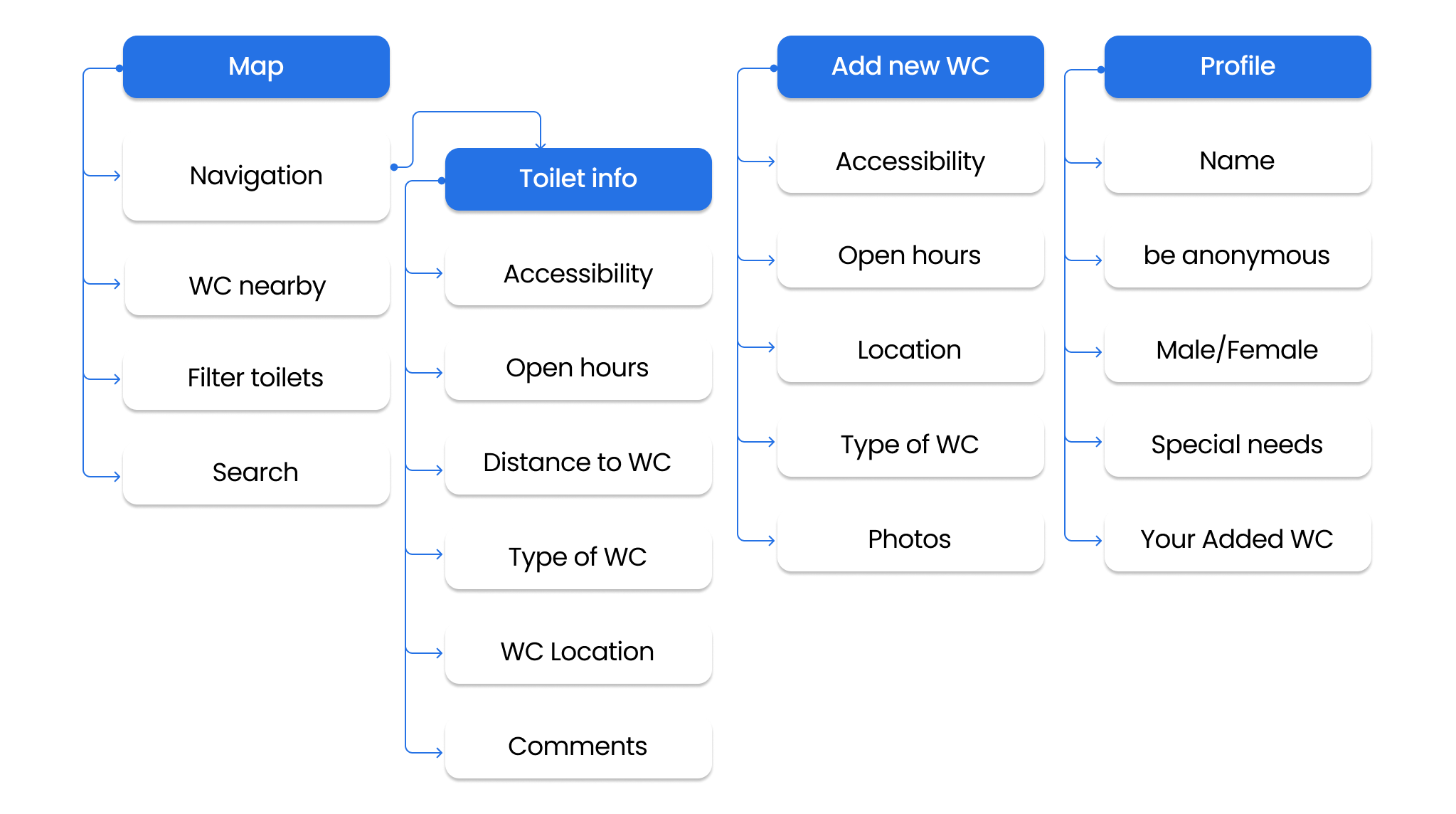
User Flow
I crafted user flows for two primary scenarios: finding a public toilet immediately and adding a new toilet to the map. For users, these flows are designed to be intuitive and efficient, guiding them step-by-step through their desired actions. Whether locating a restroom in a pinch or contributing valuable information to help others, the user flows are tailored to enhance usability and satisfaction.
In essence, mapping the app's structure and designing user flows are important steps in creating a user-friendly Hidden Toilets App. They not only simplify navigation but also ensure that the app meets the practical needs and expectations of users.

I also developed a low-fidelity prototype and tested it with a small group of users. This process allowed me to gather feedback early in the design phase, identifying pain points and refining the user flow. By iterating based on user insights, I ensured that the app's interface and functionality align closely with user expectations and needs.
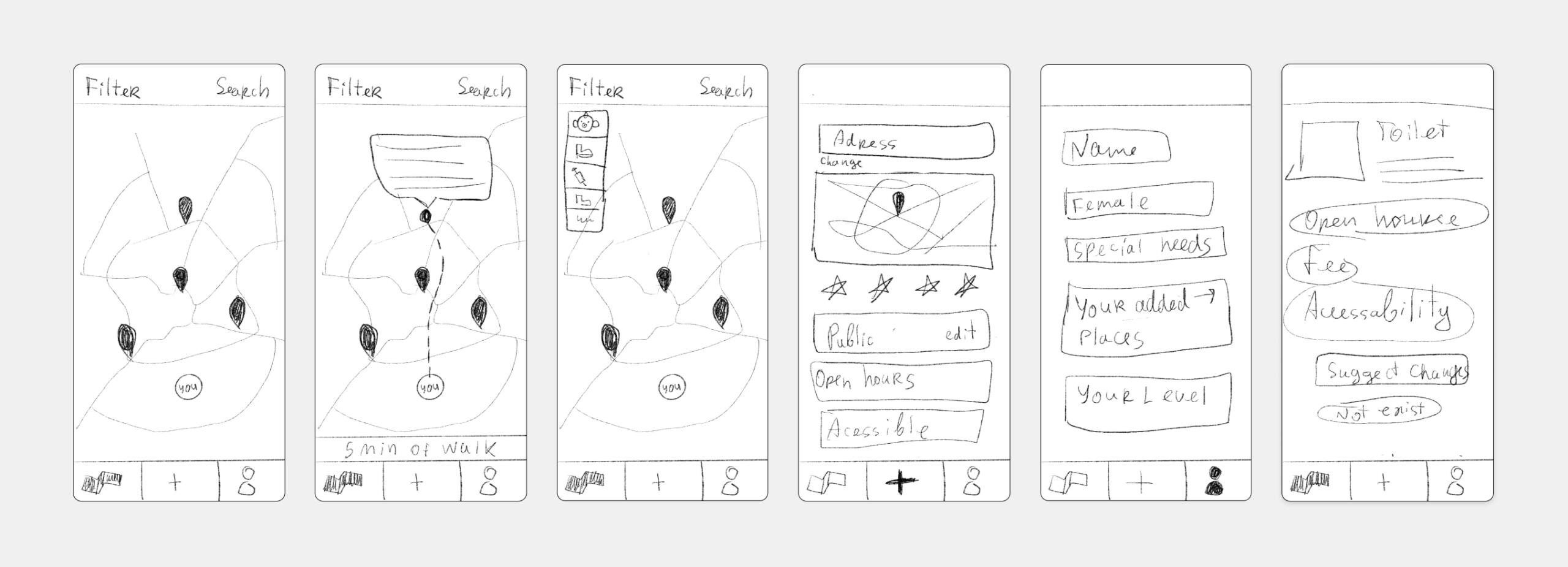
Moving from low-fidelity to mid-fidelity prototypes was critical to refining the Public Toilet Finder app. Building on insights from tools such as the site map and user flow, I focused on improving functionality, particularly in the areas of filtering options and toilet information accessibility. User testing validated these improvements and ensured that the app met user expectations for ease of use and efficiency. This iterative design process bridges conceptual ideas with practical application, making the app more intuitive and effective for users, especially those navigating unfamiliar cities.

Design Phase
The design was an interesting challenge, as the topic of toilets is considered intimate and inappropriate for display. I built on the positive associations with toilets, such as cleanliness, light, and safety. So my chosen colors and UI elements had to correspond to this theme.
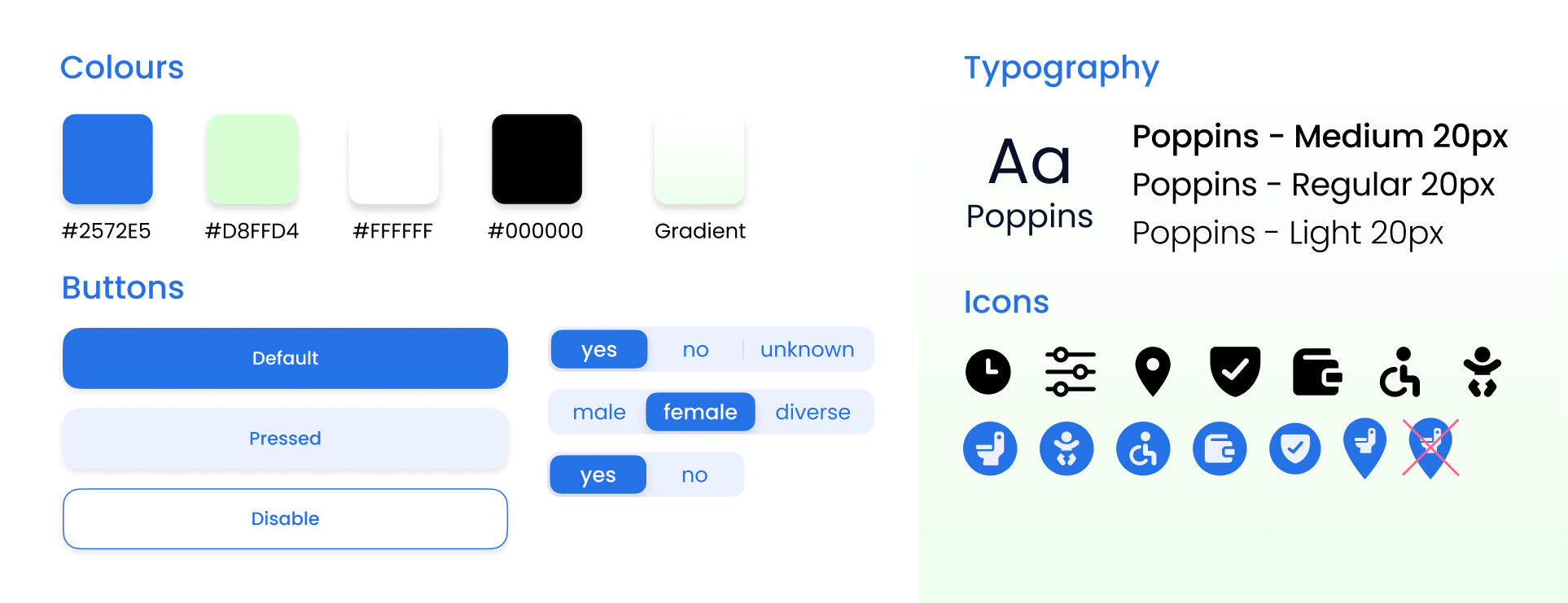
On the map, users will notice two types of toilet markers. Blue markers represent verified toilets, while gray markers indicate those needing confirmation. When multiple registered users confirm the presence of a gray-marked toilet, it will turn blue.
Users can also filter toilets based on specific needs, such as finding facilities with changing tables for parents with babies. Just click on the relevant icon and only suitable toilets will be displayed.
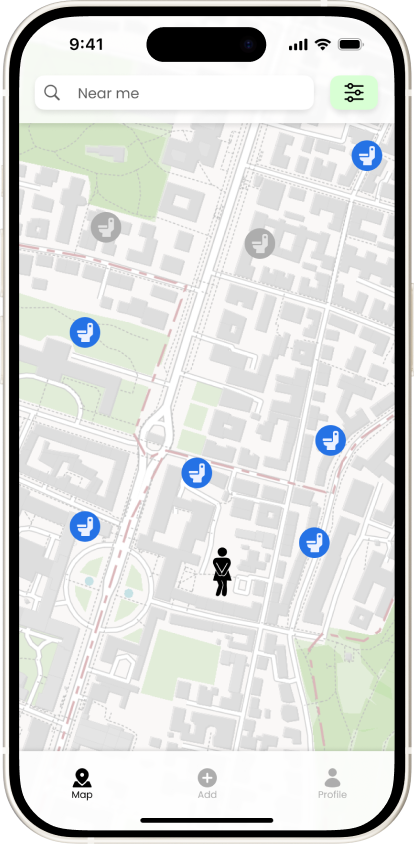
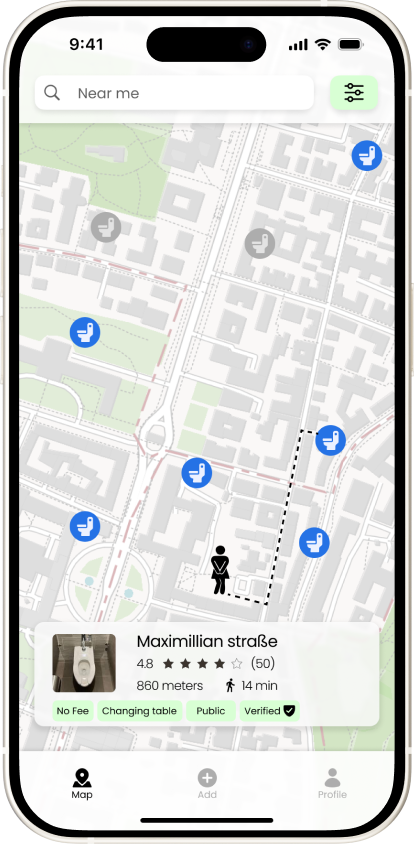
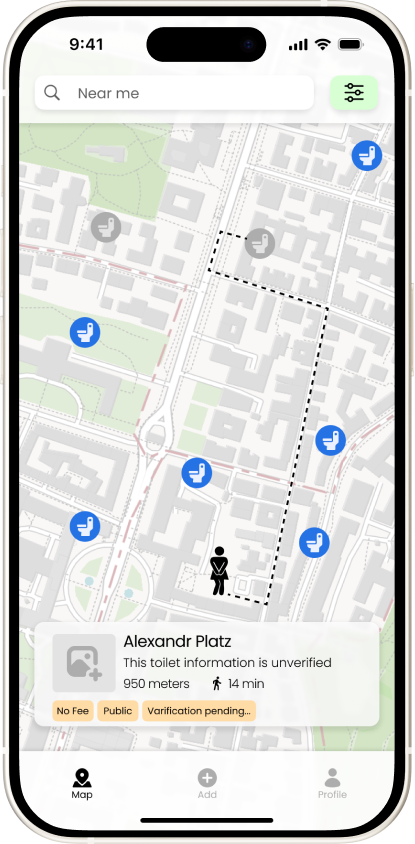
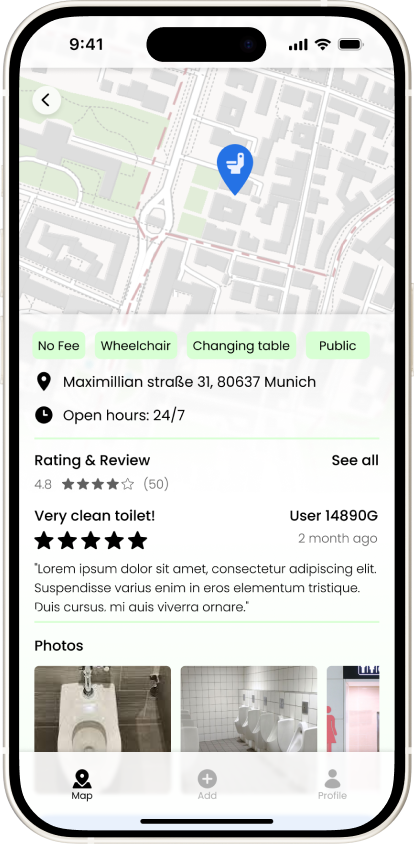

On the map, users will notice two types of toilet markers. Blue markers represent verified toilets, while gray markers indicate those needing confirmation. When multiple registered users confirm the presence of a gray-marked toilet, it will turn blue.
Users can also filter toilets based on specific needs, such as finding facilities with changing tables for parents with babies. Just click on the relevant icon and only suitable toilets will be displayed.
When users select a toilet in the app, they can view detailed descriptions and accessibility information. They can also read and leave comments, which is useful for reporting specific details or issues. If users prefer, they can navigate to the toilet using other map apps.

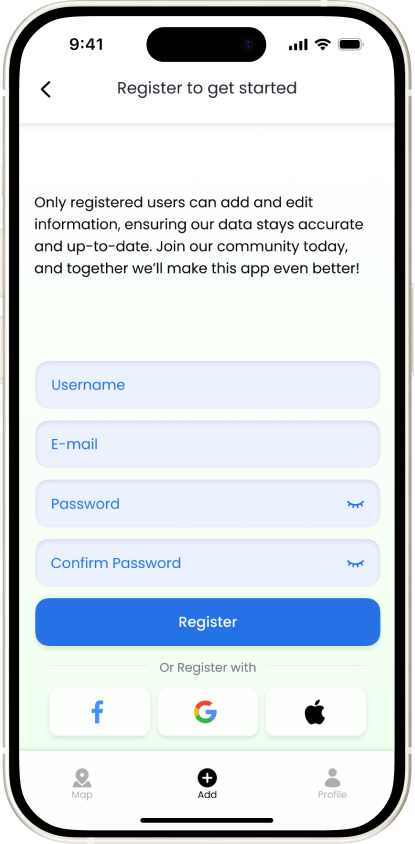

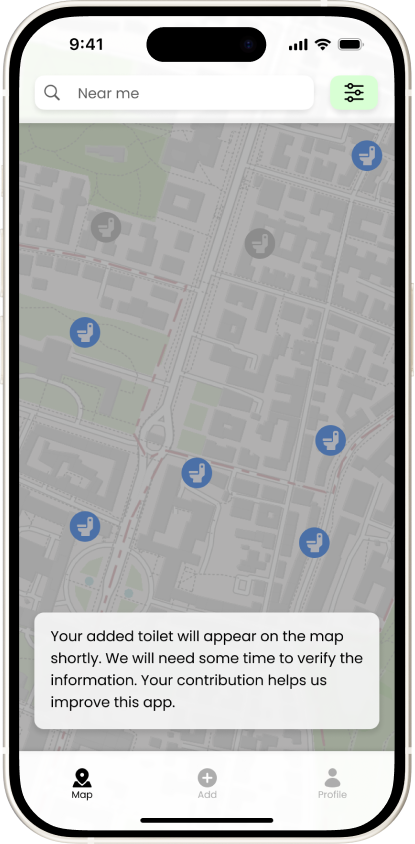

Additionally, users have the option to mark a restroom as non-existent or suggest updates, ensuring the app remains accurate and helpful.
To add a new toilet, registration is required to ensure the information's authenticity. Once registered, user’ll unlock additional features like correcting toilet information, saving locations in their profile, adding photos, and contributing to the app's development.
After registering, users can set up a profile where specifying their gender will customize the toilet search icon. They can also add personal needs, and the app will adjust the search accordingly.
Prototype
The Hidden Toilets project has been an exciting challenge that combined user research, problem-solving, and creative execution. It allowed me to dive deep into issues of accessibility and improve the urban experience through design.
The project is currently in the implementation phase, with more testing, iteration, and refinement ahead.This is just the beginning — and I’m looking forward to seeing where it leads.You can explore the current prototype in Figma and watch the video walkthrough for a closer look at the solution in action.
© 2025 Iryna Kuzmenko. All rights reserved.